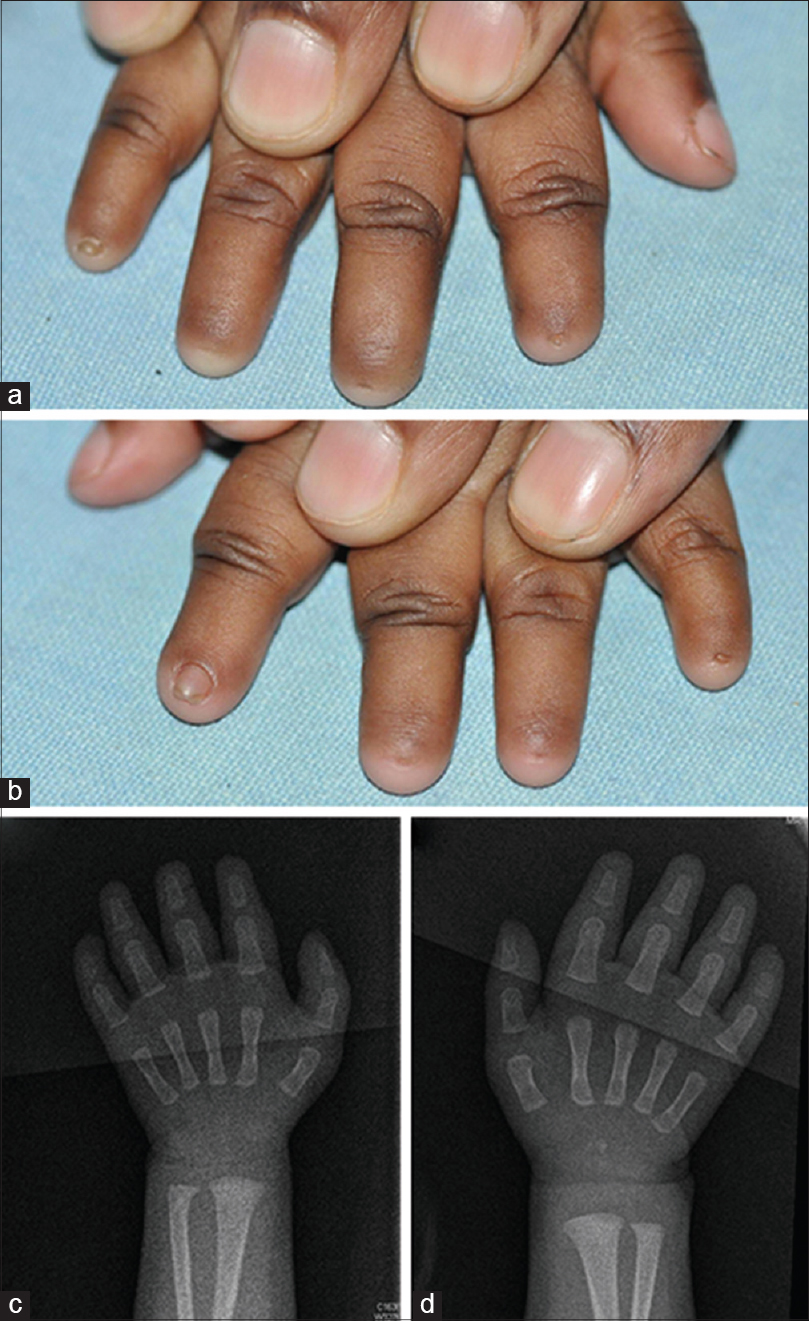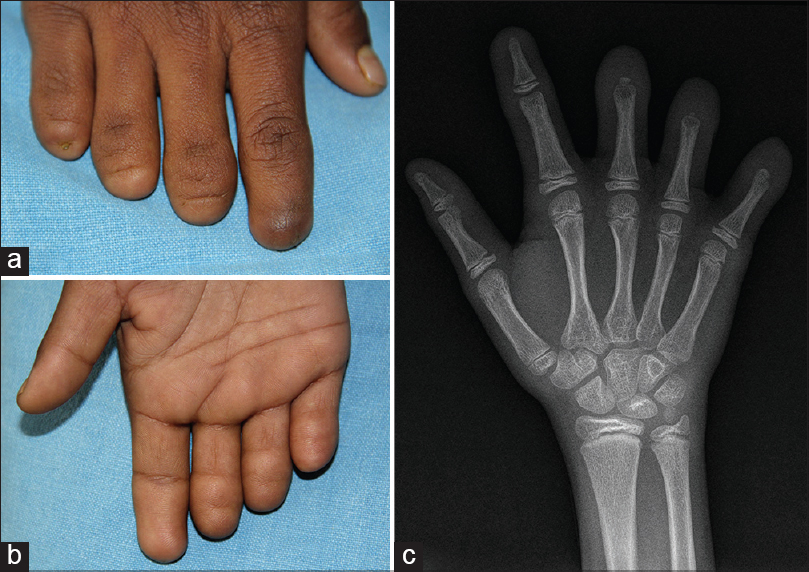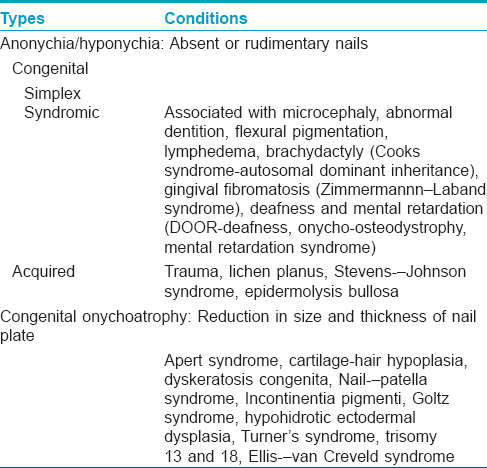Translate this page into:
Anonychia with absent phalanges and brachydactyly: A report of two unrelated cases
2 Department of Radiology, Venereology and Leprosy, Christian Medical College and Hospital, Vellore, Tamil Nadu, India
Correspondence Address:
Renu E George
Department of Dermatology, Venereology and Leprosy, Christian Medical College and Hospital, Vellore - 632 004, Tamil Nadu
India
| How to cite this article: Ramassamy S, Gibikote S, George RE. Anonychia with absent phalanges and brachydactyly: A report of two unrelated cases. Indian J Dermatol Venereol Leprol 2016;82:693-695 |
Sir,
Congenital anonychia or its milder phenotypic counterpart, hyponychia, is a relatively rare abnormality of nail development affecting all or some of the finger and toe nails, characterized by the complete absence of nails or the presence of only rudimentary nails, respectively. It could occur as an isolated abnormality, termed anonychia simplex or as part of a syndrome.[1] We report two cases of partial hyponychia/anonychia with underlying absent distal phalanges in both, and in addition hypoplastic/absent middle phalanges in one of them.
A 35-day-old female child, second born to non-consanguineous parents was brought with absent finger nails since birth. The mother denied any intake of medication or illness during the antepartum period. There was no similar history in the family. The child had short digits along with rudimentary nails of digits 2, 3, and 5 of the right hand and digit 5 of the right hand with absence of nails on digit 4 of the right hand and digits 3 and 4 of the left hand; the nails of the index finger of left hand, both thumbs and all toes were normal [Figure - 1]a and [Figure - 1]b. The head circumference was 35 cm (50th centile for age) and there was no facial dysmorphism. The skin did not reveal any pigmentary abnormality. The plain radiograph of both the hands revealed the absence of distal phalanges of digits 2-5 [Figure - 1]c and [Figure - 1]d. The child's pelvis X-ray did not show iliac horns, the renal function was normal and the ultrasound of abdomen did not show any renal abnormality. The child's brainstem-evoked response audiometry (BERA) was also normal.
 |
| Figure 1: (a and b) The fi rst patient showing brachydactyly, rudimentary nails of digits 2, 3, 5 of the right hand and digit 5 of the left hand with absence of nails of digit 4 of the right hand and digits 3 and 4 of the left hand. (c and d) Plain radiograph of both the hands showing the absence of distal phalanges of digits 2–5 |
Our second case was a 11-year-old girl, second born of a non-consanguineous marriage, with congenital absence of nails of the right hand. There was neither a positive family history nor a history of maternal drug intake during pregnancy. Her right hand had shortened digits 2-4 with poorly defined finger creases. Digits 3 and 4 had anonychia, whereas the little finger and index finger nails were hypoplastic [Figure - 2]a and [Figure - 2]b. The nails of the right thumb, all digits of the left hand and all toes were normal. X-ray showed absence of middle and distal phalanges of digits 3-5 and absence of distal phalanx with hypoplasia and tapering of the middle phalanx of digit 2 of the right hand. There were rudimentary epiphyses seen in digits 3, 4 and 5 of the right hand [Figure - 2]c. She had no other cutaneous abnormalities.
 |
| Figure 2: (a) The second patient showing shortened digits 2-4 of the right hand. Digits 3 and 4 have anonychia, whereas the little fi nger and index fi nger nails are hypoplastic. (b) Showing poorly defi ned fi nger creases of the right hand. (c) Plain radiograph of the right hand showing absence of middle and distal phalanges of digits 3–5 and absence of distal phalanx with hypoplasia and tapering of the middle phalanx of digit 2 |
Congenital anonychia/hyponychia is a spectrum of nail abnormalities which often occur concurrently in an individual. It is inherited as an autosomal dominant or recessive trait or can occur sporadically.[1] Simple anonychia has been identified to be due to mutation in R-spondin 4- gene and some cases of SOX9 duplication are reported as causes of brachydactyly-anonychia. Onychoatrophy, on the other hand, is distinct from hyponychia in that the nails are reduced in size and thickness. [Table - 1] lists the associations of anonychia/hyponychia and causes of onychoatrophy.

Cooks et al. had initially described a distinctive syndrome occurring in two generations of a family of anonychia, brachydactyly of the 5th digit of the hands and digitalization of the thumbs with absence and/or hypoplasia of the distal phalanges of the hands and feet.[2] Since then, some cases have been identified akin to the syndrome.[3],[4] Our cases had partial hyponychia/anonychia involving some of the finger nails with normal toe nails along with brachydactyly of the affected digits. They both had in common absence of phalanges (distal phalanges in both the cases along with tapering/absent middle phalanges in the second) on radiographs of the hands. They had no other associated abnormalities associated and no family history of a simialr abnormality. Genetic analysis was not performed in our cases.
Financial support and sponsorship
Nil.
Conflicts of interest
There are no conflicts of interest.
| 1. |
Al Hawsawi K, Al Aboud K, Alfadley A, Al Aboud D. Anonychia congenita totalis: A case report and review of the literature. Int J Dermatol 2002;41:397-9.
[Google Scholar]
|
| 2. |
Cooks RG, Hertz M, Katznelson MB, Goodman RM. A new nail dysplasia syndrome with onychonychia and absence and/or hypoplasia of distal phalanges. Clin Genet 1985;27:85-91.
[Google Scholar]
|
| 3. |
Nevin NC, Thomas PS, Eedy DJ, Shepherd C. Anonychia and absence/hypoplasia of distal phalanges (Cooks syndrome): Report of a second family. J Med Genet 1995;32:638-41.
[Google Scholar]
|
| 4. |
Brennan CB, Buehler T, Lesher JL Jr., Cooks syndrome: A case report and brief review. Pediatr Dermatol 2013;30:e52-3.
[Google Scholar]
|
Fulltext Views
8,437
PDF downloads
2,163





